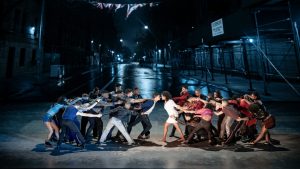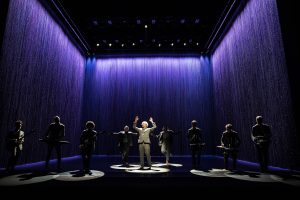
The overture begins. When the action starts a cameraman is filming the performers on stage. Images are projected on the large screen. West Side Story was a reasonable success on Broadway when it opened in 1957. The Academy Award winning film is the vehicle which projected this musical into classic status.
Hiring Ivo Van Hove to direct this third major Broadway revival signaled an intent to push the boundaries of what came before. Controversy swirled. Rumors of choreography changes in previews to go back to Jerome Robbins’ justifiably praised original. I have never seen a stage production of West Side Story and my movie memory is positive but decades old. I eagerly anticipated this revival. From my seat, this version is a mixed bag.
Gang members have cell phones so this revision is clearly an update. The best change relates to the gangs. These are not shiny chorus kids who are brilliant hoofers, although there are some very accomplished dancers on the stage. The Sharks and the Jets are more menacing here. The American versus Puerto Rican angle has been abandoned for significant diversity on both sides. These gangs are territorial focused rather than ethnically divided.
That change enables tensions with Police Officer Krupke (Danny Wolohan) to spotlight racial tensions and draw parallels to dynamics with law enforcement today. Amidst the swirling hormones and turf wars, a contemporary view emerges. Maria and Tony seem to fall deeply in love in three seconds. The core relationship at the center – and its intensity – is presented but not established in a remotely believable time frame. This choice may be commenting on the pace of coupling today enabled by technology and apps.
The whole show takes place over two days. Scenes are time stamped on the big screen. I presume the information was intended to ratchet up tension. I found the information undermined the storytelling. Did we really demonstrate “One Hand, One Heart” that quickly?
This West Side Story is largely spellbinding to watch. More than occasionally, however, the stage is barren of set and people. The video projections kick in. The locations where Tony and Maria work are rooms visible at the back of the stage. When the cast enters those areas they essentially leave the stage. The detail within the scenes is pretty cool. If you pull yourself away from the movie, you realize that the very large stage is empty. It’s compelling and puzzling at the same time.
What is not cool is the song “Cool” which is the low point of the musical numbers. A number of songs have been cut including “I Feel Pretty” which is not missed at all. Singing is not the strong point of this revival and the vocal styles are very mixed. That’s not necessarily a bad thing. The development of characters and mood are clearly more central in the casting choices. If you come expecting glorious vocals, however, you will be disappointed.
Isaac Powell and Shereen Pimentel have nice chemistry as Tony and Maria. Their vocals are mismatched but that contradiction was additive. I found myself engaged with their story arc. They are the core of this show. Everything around them is busy but they manage to ground the story when they appear.
Mr. Van Hove’s use of projections on stage has been escalating. The staging of Network was intense. We watch Bryan Cranston melting down on stage and also see the television viewers’ perspective. In West Side Story, projections are scenery. The camera rolls down the street as the gang walks. Other times multiple images are maniacally flashing. The people on stage cannot compete with the overly distracting visual projections.
This West Side Story is a gallimaufry. Parts are very engrossing with an updated edginess. (Should there be a moratorium on stage rain at this point? Discuss among yourselves.) The musical numbers are largely unexceptional. I enjoyed the choreography by Anne Teresa De Keersmaeker. Hers is not Jerome Robbins at all but fit the style of this show. The sections of this production which sag give you time to wonder if this is conceptual filmmaking more than a theatrical presentation. That is a stimulating idea but an empty stage in a grand Broadway house will not be everyone’s cup of tea.
West Side Story is playing at the Broadway Theatre.





You must be logged in to post a comment.